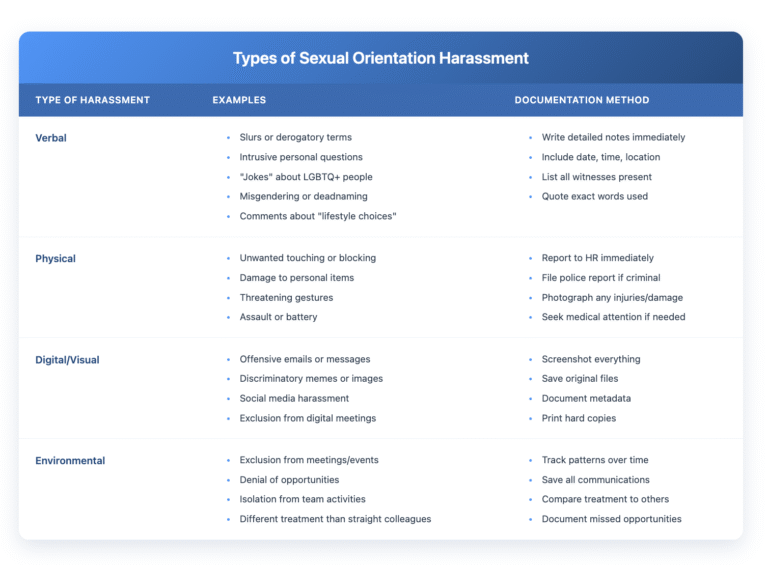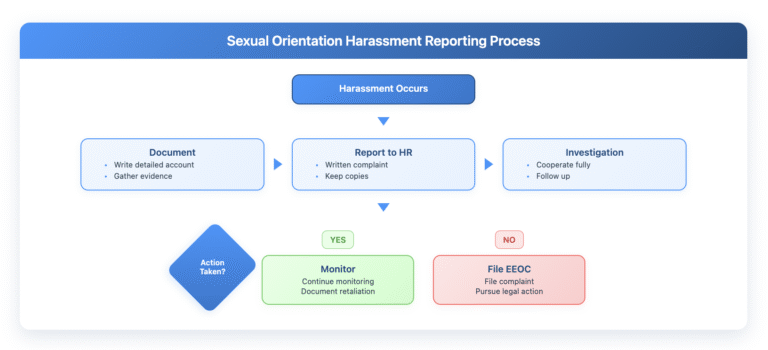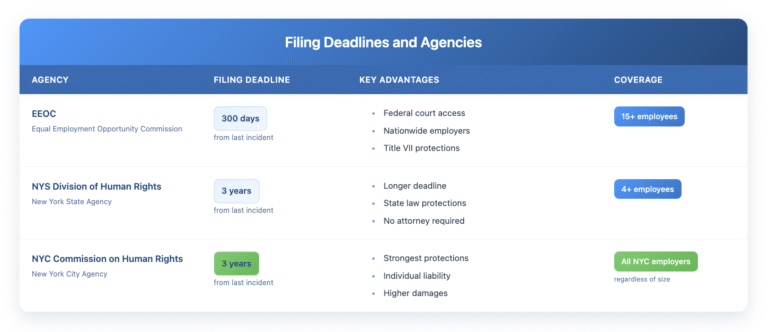If you’re facing harassment at work because of your sexual orientation, you have legal rights and options. Whether it’s hostile comments, exclusion from opportunities, or threats to your safety, sexual orientation harassment violates federal and state employment laws. Here’s what you need to know to protect yourself and hold your employer accountable.
The law is on your side. Title VII of the Civil Rights Act, as interpreted by the Supreme Court in Bostock v. Clayton County (2020), prohibits discrimination based on sexual orientation. In New York, you have even stronger protections under state and local laws.
Disclaimer: This article provides general information for informational purposes only and should not be considered a substitute for legal advice. It is essential to consult with an experienced employment lawyer at our law firm to discuss the specific facts of your case and understand your legal rights and options. This information does not create an attorney-client relationship.
What Legally Qualifies as Sexual Orientation Harassment?
Sexual orientation harassment isn’t just about obvious slurs or threats. It includes any unwelcome conduct based on your actual or perceived sexual orientation that creates a hostile work environment or results in adverse employment actions.
The harassment must be either severe (a single extremely serious incident) or pervasive (a pattern of offensive behavior over time). One inappropriate joke might not meet the legal standard, but repeated comments, even if seemingly “minor,” can absolutely constitute illegal harassment.
Common Forms of Harassment You Should Document
Verbal harassment remains the most frequent type employees encounter. This includes derogatory comments about your sexual orientation, intrusive questions about your personal life, or “jokes” that target LGBTQ+ individuals. Even comments disguised as religious concerns or “lifestyle disagreements” can constitute harassment when they create a hostile environment.
Physical harassment ranges from unwanted touching to vandalism of personal property. Any physical intimidation or threats based on sexual orientation demand immediate documentation and reporting.
Visual harassment includes offensive images, emails, or social media posts targeting your sexual orientation. Screenshots and copies of these materials become crucial evidence.

Understanding the Legal Standards
The “Severe or Pervasive” Test
Courts evaluate harassment claims using specific criteria. A single incident can be “severe” enough if it involves physical threats, assault, or extremely degrading conduct. More commonly, harassment becomes illegal when it’s “pervasive” – meaning it happens repeatedly over time.
Factors courts consider include:
- Frequency of the discriminatory conduct
- Its severity
- Whether it’s physically threatening or humiliating
- Whether it unreasonably interferes with your work performance
Employer Liability: When Your Company Is Responsible
Your employer can be held liable for sexual orientation harassment in several situations. If a supervisor harasses you and takes tangible employment action (like firing, demotion, or denial of promotion), the company is automatically liable.
For harassment by coworkers or harassment by supervisors that doesn’t result in tangible action, your employer becomes liable if they knew or should have known about the harassment and failed to take prompt, effective corrective action.
Building Your Case: Documentation Is Everything
Strong documentation transforms your experience from “he said/she said” into a compelling legal case. Start documenting immediately, even if you’re not sure you’ll take legal action.
Your Documentation Checklist
Create a harassment log that includes:
- Date and time of each incident
- Location where it occurred
- Who was involved (harasser and any witnesses)
- Exactly what was said or done (use quotes when possible)
- How you responded
- Impact on your work and wellbeing
- Any evidence (emails, texts, photos)
Keep this log at home or in a personal email account – never on company systems. Update it regularly while events are fresh in your memory.
Gathering Supporting Evidence
Beyond your personal log, collect every piece of evidence available. Save offensive emails, texts, or social media posts. If harassment occurs through company communication systems like Slack or Teams, take screenshots before anything can be deleted.
Request copies of your personnel file and performance reviews. Positive evaluations before the harassment started can help prove that any negative employment actions were retaliatory, not performance-based.

Reporting Harassment: Navigate the Process Strategically
Internal Reporting: Your First Step
Most companies require you to report harassment internally before taking legal action. Check your employee handbook for specific procedures. Even if not required, internal reporting creates a paper trail showing you gave your employer the chance to fix the problem.
Submit your complaint in writing, even if you also report verbally. Email creates a timestamp and prevents disputes about what you reported and when. Include specific examples from your documentation, but you don’t need to share everything at this stage.
What to Include in Your Written Complaint
Your written complaint should clearly state:
- You’re experiencing harassment based on sexual orientation
- Specific examples of harassment (2-3 most serious incidents)
- How is it affecting your work
- What resolution are you seeking (stop the harassment, training, transfer of harasser, etc)
Keep the tone professional and factual. Avoid emotional language or threats of legal action at this stage.
When Your Employer Fails to Act
If your employer doesn’t respond appropriately to your complaint, or if the harassment continues or worsens, it’s time to explore external options.
Filing with the EEOC or State Agency
You must file a charge with the Equal Employment Opportunity Commission (EEOC) before suing in federal court. In New York, you can also file with the New York State Division of Human Rights or the New York City Commission on Human Rights, which often provide stronger protections and longer filing deadlines.
Federal EEOC charges must be filed within 300 days of the last incident of harassment. New York State gives you three years, and New York City provides three years as well.

Retaliation: Know the Warning Signs
Retaliation for reporting harassment is illegal, but it happens frequently. Watch for these red flags after making a complaint:
- Sudden negative performance reviews
- Exclusion from meetings or projects
- Schedule changes or transfer to a less desirable position
- Increased scrutiny or impossible deadlines
- Hostile treatment from management
- Termination or demotion
Document any changes in how you’re treated after reporting harassment. Retaliation claims can be easier to prove than the underlying harassment and often result in additional damages.
Protecting Your Mental Health During the Process
Experiencing harassment takes a serious toll on your mental and emotional well-being. While pursuing your legal rights, prioritize self-care.
Consider seeking support from a therapist experienced with LGBTQ+ issues and workplace trauma. Many employers offer Employee Assistance Programs (EAPs) that provide free counseling sessions. These conversations are confidential and can’t be used against you.
Document the emotional impact of harassment, including anxiety, depression, sleep problems, or physical symptoms. This documentation can support claims for emotional distress damages. If you need medical treatment or therapy, keep all records and receipts.
Understanding Your Damages
If you prove sexual orientation harassment, you may recover several types of compensation:
Economic damages include lost wages, lost benefits, and job search expenses if you were terminated. Future lost earnings may be available if the harassment affected your career trajectory.
Non-economic damages compensate for emotional distress, pain and suffering, and loss of enjoyment of life. These damages recognize the real harm harassment causes beyond just financial losses.
Punitive damages may be available in cases of particularly egregious conduct, designed to punish the employer and deter future discrimination.
State and Local Protections: Your Additional Rights
New York State Human Rights Law
New York’s Human Rights Law explicitly prohibits sexual orientation discrimination and harassment. It covers all employers with four or more employees and has no cap on damages. The law also allows individual liability, meaning you can sue harassers personally, not just the company.
New York City Human Rights Law
New York City provides the nation’s strongest protections against sexual orientation harassment. The law covers all employers regardless of size and includes protection for gender identity and expression. It also requires employers to engage in “cooperative dialogue” about accommodations and creates liability for failing to investigate complaints properly.
Take Action Now: Your Next Steps
Don’t wait for harassment to escalate before taking action. The sooner you document and report, the stronger your legal position becomes.
Start documenting today. Even if past incidents weren’t documented, write down everything you remember with approximate dates. Moving forward, document every incident immediately.
Review your employee handbook. Understand your company’s harassment policy and reporting procedures. Follow them exactly, even if they seem ineffective.
Secure your evidence. Forward any relevant emails to a personal account. Back up text messages and photos. Store everything safely outside of work.
Build your support network. Identify supportive colleagues who might serve as witnesses. Connect with LGBTQ+ employee resource groups if available.
Know your deadlines. Mark your calendar with filing deadlines based on when harassment started. Don’t let time limits expire while deciding what to do.
When to Contact an Employment Attorney
While you can file EEOC or state agency charges yourself, an experienced employment attorney can significantly strengthen your case. Consider contacting an attorney if:
- Your employer hasn’t stopped the harassment after you reported it
- You’ve experienced retaliation for complaining
- You’ve been terminated, demoted, or forced to resign
- The harassment is severe or involves physical threats
- You’re unsure about your legal options or deadlines
Sexual orientation harassment violates your fundamental right to work with dignity and respect. You deserve a workplace free from discrimination, and the law provides powerful tools to make that happen.
If you’re facing sexual orientation harassment at work, you don’t have to navigate this alone. Contact Nisar Law Group for a consultation about your situation. Our experienced employment attorneys understand the complexities of sexual orientation discrimination cases and can help you evaluate your options, protect your rights, and pursue the justice you deserve. Call us today to discuss how we can help you move forward with confidence.


